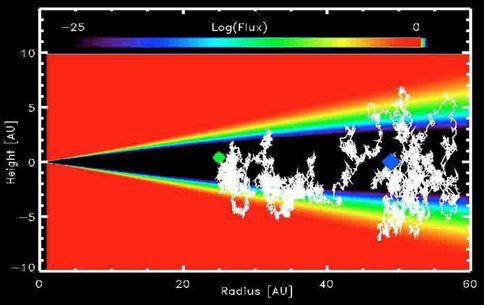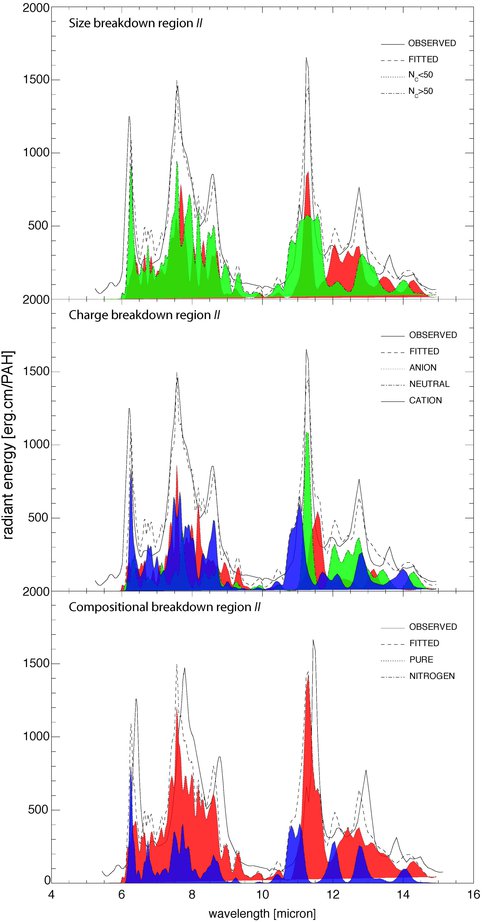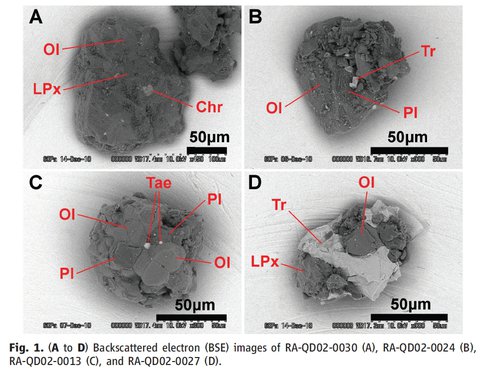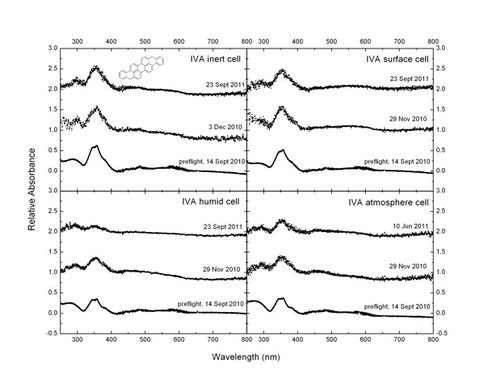2012 Annual Science Report
 NASA Ames Research Center
Reporting | SEP 2011 – AUG 2012
NASA Ames Research Center
Reporting | SEP 2011 – AUG 2012
Cosmic Distribution of Chemical Complexity
Project Summary
The three tasks of this project explore the connections between chemistry in space and the origin of life. We start by tracking the formation and evolution of chemical complexity in space, from simple carbon-rich molecules such as formaldehyde and acetylene to complex species including amino acids, nucleic acids and polycyclic aromatic hydrocarbons. The work focuses on carbon-rich species that are interesting from a biogenic perspective and on understanding their possible roles in the origin of life on habitable worlds. We do this by measuring the spectra and chemistry of analog materials in the laboratory, by remote sensing with small spacecraft, and by analysis of extraterrestrial samples returned by spacecraft or that fall to Earth as meteorites. We then use these results to interpret astronomical observations made with ground-based and orbiting telescopes.
Project Progress
(1) We have published several papers, and are working on others, that describe the production of prebiotic compounds by UV irradiation of cosmic ices. One of the published papers appeared in Astrobiology and described work showing the photolysis of pyrimidine in astrophysical ices produces a host of new compounds, including the nucleobases uracil and cytosine (Figure 1).
Figure 1. The reaction paths by which the UV photolysis of pyrimidine in cosmic ices leads to the production of the nucleobases uracil and cytosine (from Nuevo et al. 2012).
Additional papers (completed and in process) describe the modeling of photolytic production of organics in the protosolar disk (Figure 2), and work done with the recently fallen Almahata Sitta and Sutter’s Mill meteorites.
Figure 2. A diagram showing the motion of a dust particle in the protosolar disk. During these travels, the dust grain accumulates ices while deep in the disk. These icy dust grains are subsequently irradiated when they are near the disk’s surface. This process is expected to convert volatiles in the disk into more complex organic materials (from Ciesla and Sandford 2012).
(2) We substantially expanded content and capabilities of the PAH IR spectroscopic database (PAHdb) to support Spitzer, SOFIA, Herschel and JWST. A major highlight is the inclusion of the capability to directly import astronomical spectra and fit them with database spectra, providing deep new insight into the evolution of PAHs in different environments spanning the universe. We have routinely assisted users develop new PAHdb applications to PAH-related problems (PAHs in Titan, PAHs in Interstellar ices…). We are creating 2d-maps from Spitzer observations, showing UV-driven, spatial evolution of PAH subpopulations broken down by size, charge, composition, and we are relating these variations to changes in an object’s morphology, radiation field, PDR boundary, etc. (Figure 3).
Figure 3. Breakdown of the 5 – 15 µm PAH emission spectrum at one position in the diffuse region of Reflection Nebula NGC 7023 into PAH subclasses by size (top), charge (middle) and composition (bottom). Thanks to PAHdb, this information is now available at 300 positions in this reflection nebula, accordingly it helps to correlate the growth, evolution and destruction of PAH and fullerene with local conditions within the nebula.
We published four papers on the following topics: i – extension of spectra in PAHdb from C130H28 to C384H48 with astronomical applications, ii – long wavelength (15 – 20 µm) IR PAH emission based on spectra in PAHdb, iii – Analyzed spectral changes along 11 lines-of-sight in Orion PDR, tracking stepwise evolution of PAHs and fullerenes and iv – photochemistry of PAHs in NH3 and mixed H2O/NH3 ices (Figure 4).
Figure 4. HST-ACS visible (left) and Spitzer IRAC false color IR (right) images of a 12 square-arcsecond region southwest of the ionization ridge in Orion (top right both images). The red star shows the position of the exciting star, theta1 C Orion. The “+” symbols indicate the 11 positions probing PAHs and fullerenes using PAHdb.
(3) Mission involvement- Co-I Sandford continues contribute to the extraction, distribution, and analysis of cometary and interstellar samples returned by the Stardust mission. Several manuscripts that interpret several potential interstellar grains in the Stardust collection are almost ready for submission to the journals Science and Meteoritics and Planetary Science. He also continues to be actively involved with the study of asteroidal samples returned by the Japanese Hayabusa mission and publishing relevant papers (Figure 5).
Figure 5. Examples of particles returned from asteroid Itokawa by the Hayabusa spacecraft (from Nakamura et al., 2011).
Co-I Sandford is also a member of the OSIRIS-Rex Asteroid Sample Return Mission, where he will have numerous responsibilities, including organizing the science team that will study the organics in the returned samples. Finally, Co-I Sandford is currently serving as the PI on a Comet Surface Sample Return mission concept for the next New Frontiers AO. Co-I Andrew Mattioda is a member of the Science Team for the O/OREOS (Organisms/ORganics Exposure to Orbital Stresses), NASA’s first Astrobiology Small Payloads mission, which launched on November 19, 2010. He works on the SEVO (Space Environment Viability of Organics) component of O/OREOS. Numerous talks have been given and the first science results of SEVO have been published in a featured article in the journal Astrobiology. This paper discusses the chemical changes occurring in the PAH (isoviolanthrene) in a variety of astrobiological environments (see Figure 6) as well as the apparent stability of the quinone, anthrarufin against degradation. A second manuscript has been accepted for publication in Acta Astronautica. Several additional manuscripts that address the SEVO results and ground-control studies are in preparation.
Figure 6. UV-VIS spectra of the PAH, Isoviolanthrene (IVA, C34H18) thin film in four microenvironments (1: inert argon, 2: SiO2 surface, 3: CO2 and O2 atmosphere, and 4: humid [H2O] atmosphere). The spectra were measured with a laboratory spectrometer and light source (pre-flight) and in-flight with the SEVO spectrometer using the sun as the light source. Note the significant decrease in the ~350 nm band area in the humid cell between September 23, 2011 and November 29, 2012 (309 days), indicating the PAH’s photo-modification or destruction in this cell.
Publications
-
Boersma, C., Rubin, R. H., & Allamandola, L. J. (2012). SPATIAL ANALYSIS OF THE POLYCYCLIC AROMATIC HYDROCARBON FEATURES SOUTHEAST OF THE ORION BAR. The Astrophysical Journal, 753(2), 168. doi:10.1088/0004-637x/753/2/168
-
Ciesla, F. J., & Sandford, S. A. (2012). Organic Synthesis via Irradiation and Warming of Ice Grains in the Solar Nebula. Science, 336(6080), 452–454. doi:10.1126/science.1217291
-
Cody, G. D., Heying, E., Alexander, C. M. O., Nittler, L. R., Kilcoyne, A. L. D., Sandford, S. A., & Stroud, R. M. (2011). Establishing a molecular relationship between chondritic and cometary organic solids. Proceedings of the National Academy of Sciences, 108(48), 19171–19176. doi:10.1073/pnas.1015913108
-
Mattioda, A., Cook, A., Ehrenfreund, P., Quinn, R., Ricco, A. J., Squires, D., … Young, A. (2012). The O/OREOS Mission: First Science Data from the Space Environment Viability of Organics (SEVO) Payload. Astrobiology, 12(9), 841–853. doi:10.1089/ast.2012.0861
-
Nakamura, T., Noguchi, T., Tanaka, M., Zolensky, M. E., Kimura, M., Tsuchiyama, A., … Kawaguchi, J. (2011). Itokawa Dust Particles: A Direct Link Between S-Type Asteroids and Ordinary Chondrites. Science, 333(6046), 1113–1116. doi:10.1126/science.1207758
-
Naraoka, H., Mita, H., Hamase, K., Mita, M., Yabuta, H., Saito, K., … Kawaguchi, J. (2012). Preliminary organic compound analysis of microparticles returned from Asteroid 25143 Itokawa by the Hayabusa mission. GEOCHEMICAL JOURNAL, 46(1), 61–72. doi:10.2343/geochemj.1.0134
-
Nuevo, M., Milam, S. N., & Sandford, S. A. (2012). Nucleobases and Prebiotic Molecules in Organic Residues Produced from the Ultraviolet Photo-Irradiation of Pyrimidine in NH 3 and H 2 O+NH 3 Ices. Astrobiology, 12(4), 295–314. doi:10.1089/ast.2011.0726
-
Nuevo, M., Milam, S. N., Sandford, S. A., De Gregorio, B. T., Cody, G. D., & Kilcoyne, A. L. D. (2011). XANES analysis of organic residues produced from the UV irradiation of astrophysical ice analogs. Advances in Space Research, 48(6), 1126–1135. doi:10.1016/j.asr.2011.05.020
-
Peeters, E., Tielens, A. G. G. M., Allamandola, L. J., & Wolfire, M. G. (2012). THE 15–20 μm EMISSION IN THE REFLECTION NEBULA NGC 2023. The Astrophysical Journal, 747(1), 44. doi:10.1088/0004-637x/747/1/44
-
Ricca, A., Bauschlicher, C. W., Boersma, C., Tielens, A. G. G. M., & Allamandola, L. J. (2012). THE INFRARED SPECTROSCOPY OF COMPACT POLYCYCLIC AROMATIC HYDROCARBONS CONTAINING UP TO 384 CARBONS. The Astrophysical Journal, 754(1), 75. doi:10.1088/0004-637x/754/1/75
-
Tsuchiyama, A., Uesugi, M., Matsushima, T., Michikami, T., Kadono, T., Nakamura, T., … Kawaguchi, J. (2011). Three-Dimensional Structure of Hayabusa Samples: Origin and Evolution of Itokawa Regolith. Science, 333(6046), 1125–1128. doi:10.1126/science.1207807
- Cuylle, S.H., Tenenebaum, E.D., Bouwman, J., Linnartz, H. & Allamandola, L.J. (2012). Lyman-alpha Induced Charge Effects of PAHs Embedded in Ammonia and Ammonia: Water Ice. Monthly Notices of the Royal Astronomical Society.
- Sandford, S.A. (2011). The Power of Sample Return Missions -Stardust and Hayabusa. In Proceedings of the IAU Symposium #280 – “The Molecular Universe”, eds. J. Cernicharo and R. Bachiller, invited paper to meeting held in Toledo, Spain, 30 May – 3 June 2011, Cambridge University Press: Cambridge. Proceedings of the IAU Symposium, 280: 275-287.
-
PROJECT INVESTIGATORS:
-
PROJECT MEMBERS:
Murthy Gudipati
Co-Investigator
Andrew Mattioda
Co-Investigator
Scott Sandford
Co-Investigator
Max Bernstein
Collaborator
Jan Cami
Collaborator
Jamie Cook
Collaborator
Jason Dworkin
Collaborator
Els Peeters
Collaborator
Christiaan Boersma
Postdoc
Amanda Cook
Postdoc
Christopher Materese
Postdoc
Michel Nuevo
Postdoc
-
RELATED OBJECTIVES:
Objective 1.1
Formation and evolution of habitable planets.
Objective 2.1
Mars exploration.
Objective 2.2
Outer Solar System exploration
Objective 3.1
Sources of prebiotic materials and catalysts
Objective 3.2
Origins and evolution of functional biomolecules
Objective 3.4
Origins of cellularity and protobiological systems
Objective 4.3
Effects of extraterrestrial events upon the biosphere
Objective 7.1
Biosignatures to be sought in Solar System materials
Objective 7.2
Biosignatures to be sought in nearby planetary systems






